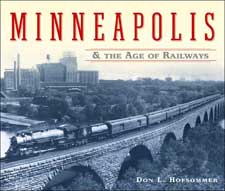
Book Review
Minneapolis and the Age of Railways
Minneapolis: University of Minnesota Press, 2005
xiv + 337 pages
Photographs, maps, notes, and index
$39.95 (cloth), ISBN 0-8166-4501-9
Minneapolis and the Age of Railways is a history of the tangle of routes and rates that grew up in Minneapolis during the heyday of this industry, 1860-1920. It is a line history of the first modern business and the largest business enterprise in the world, one which transformed the United States into an urban, industrial nation. The settlement and development of the upper Midwest, its important crops and commerce, and the rivalry among competing cities (St. Paul, Chicago, Milwaukee, and Rock Island) drove railroad expansion. This large and impressive book, which is filled with wonderful old photographs, concentrates on the Minneapolis and St. Louis, which was eventually absorbed by the Rock Island Line.
If you like your business history straight, which means driving single-mindedly ahead like the industry it describes and carrying a bewildering freight of local detail, then this is the book for you. It does well all that it sets out to do, but what it sets out to do is all too limited in its sense of history. This reviewer wanted something else.
If Hofsommer’s book is a fair example of the genre, business history seems to have remained untouched by any of the debates that have scored the discipline of history in the last half-century. Hofsommer’s narrative harks back to an earlier mentality when the object of history was a sanctified entity--like the hero, king, or nation--that always did the right thing. Anchored in Benjamin Franklin’s America, Minneapolis and the Age of Railways is an account of thrift, industry, and sharp practices in both good times and bad, a naive account of robust and heroic masculinity and its favored activity, empire-building (“business imperialism” is one of its recurring phrases; among its metaphors are “muscle,” “cardio-vascular,” and “weapon of choice”).
Hofsommer’s business history has completely lost sight of any of the railroad’s “others.” Its only horizon is the financial market; its only actors are the railroad managers (Washburn, Pillsbury, Hill, Hawley). The age of railways was a heroic endeavor done in by base-born villains, “government” and “labor,” who remain too amorphous to be particularized or rationalized. The author offers us a narrative view of an America where government is the enemy of the corporation: a counterintuitive history of a financial institution unreasonably attacked by government. Government intervention is always either “well-intentioned (but)” or “wrong-headed,” never a proper response to abuses on the part of the railroads--the author makes the political dimension a matter of shifting (and irrational) public opinion rather than entrepreneurial behavior. We read of governmental regulations spurred by anger and fear of big business, but the author never explains why this might be. In fact, the railroads soon came to dominate the regulatory commissions, and this was the rule, not the exception, for industry regulation. There is no discussion of the large-scale bribery of congress and state legislatures. Hofsommer makes no ethical assessment of America’s largest corporations in the nineteenth and twentieth centuries, but surely this part of their “history” needs telling as much as what routes were proposed and then abandoned.
Business history is apparently only management history; to talk about workers you have to write something else called “labor history.” This seems like a good way of disabling our sense of the past. Minneapolis and the Age of Railways is a history of accomplishments by an enthusiast who does not regard the human fabric of those endeavors. The men and women who worked for the railroad are barely mentioned. Railroad workers and their wives and children first appear (marginally, as they lived) in a caption to a photograph on page 132 that shows their homes, and they appear thereafter tucked into the shadowy word “labor.” (On page 219, the author criticizes labor for demanding legislation for an eight-hour day!) Hofsommer never considers Henry David Thoreau’s (2004) admonition in Walden:
Did you ever think what those sleepers are that underlie the railroad? Each one is a man, an Irishman, or a Yankee man. The rails are laid on them, and they are covered with sand, and the cars run smoothly over them. They are sound sleepers, I assure you. And every few years a new lot is laid down and run over; so that, if some have the pleasure of riding on a rail, others have the misfortune to be ridden upon (Thoreau 90).
There is no mention of the great labor agitation at the turn of the century, nor the great railway brotherhoods.
Finally in regard to the discipline of history, there is no critical weighing of evidence: the quoted material consists almost entirely of public-relations announcements from the railroads themselves or “puff-pieces” from local newspapers. The prose is sometimes lush, as in “harsh climes and difficult terrains” (13), and too often journalistic. A writer who can still use the word “balderdash” (21) is particularly equipped to extol business enterprise.
References Cited
Thoreau, H. 2004. Walden: A Fully Annotated Edition. J. Cramer, editor. New Haven, CT: Yale University Press.

